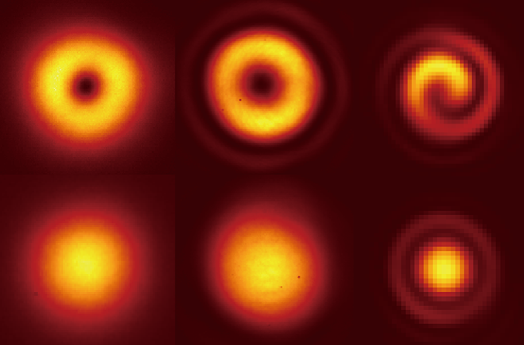
A new waveguide that can transmit twisted light within a photonic chip has been unveiled in China. It was created by Xian-Min Jin at Shanghai Jiao TongUniversity and colleagues and allows twisted light to propagate without significant degradation to its helicity. The waveguide could lead to the development of new chips for optical and quantum computing.
Characterized by its corkscrew-shaped wave fronts, twisted light carries orbital angular momentum (OAM) in a series of independent states. Each of these OAM states can be used to encode information, and this has already been used to boost the amount of data that can be transmitted using light. The quantum-mechanical nature of these states could also make twisted light useful for creating quantum computers.
An important challenge for those creating practical devices is that the effective index of refraction of a conventional solid wave guide is too low to allow the transmission of individual OAM states. Instead, states with similar OAM values will blur into each other.
The solution has been known for some time: create a “doughnut” waveguide with aninner core and concentric rings made of materials with the appropriate indices of refraction. However, this complex structure has proven notoriously difficultto fabricate.
Jin and colleagues achieved the first practical implementation of a doughnut waveguide by using a laser-writing technique. This involves firing precisely-focused, femtosecond pulses of green light at a borosilicate glasswafer. Absorption of the pulses causes highly-localized transformations of therefractive index of the glass, resulting in a 10 µm-diameter, 20 mm-longdoughnut waveguide.
The team tested their on-chip waveguide using twisted light with OAM values of +1,0, and -1, as well as each combination of superpositions of the three states.The researchers measured the intensity profiles of twisted light entering andexiting their waveguide, while also testing the helicity of the emerging lightby interfering it with a separate twisted beam fired through free space alongside the waveguide.
They found that about 40% of the initial intensity of the twisted light was lost inside the waveguide. Even greater losses were measured for states with greater OAM. They also observed that the waveguide also filtered-out photons with poorly-defined OAM. As a result, the helicity of the light remained remarkably well-preserved as it passed through the waveguide.
Jin and colleagues believe their doughnut waveguide could be used in commercially-viable,high-capacity optical communications in the near future. The physicists will now work towards increasing the transmission rates of twisted light with highervalues of OAM in their waveguide, potentially creating further opportunities in the rapidly-growing fields of quantum and optical computing.
Physicsworld: https://physicsworld.com/a/doughnut-waveguide-preserves-twisted-light/